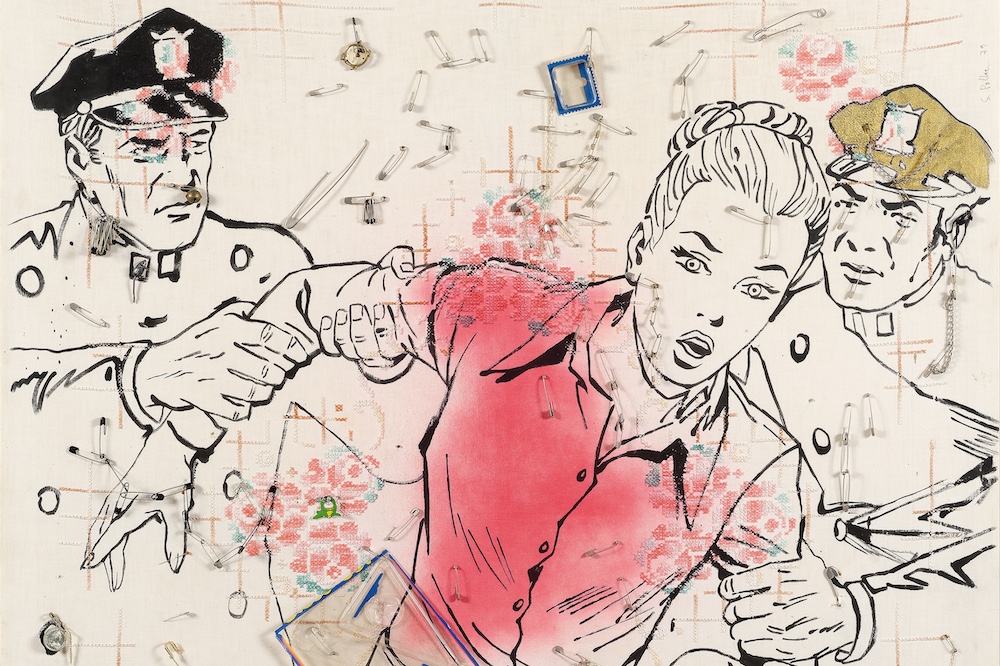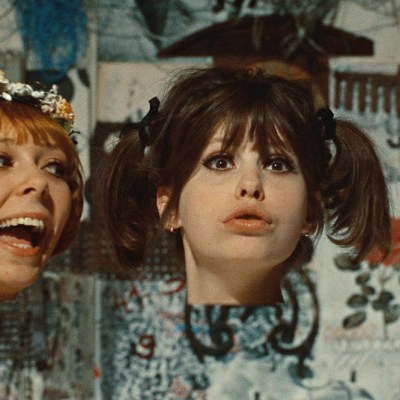The Schinkel Pavillon in Berlin is currently hosting a small survey of the work of Sigmar Polke (1941–2010), a founding member of the capitalist realism movement of the 1960s and ’70s along with Gerhard Richter and Konrad Lueg (later known as the art dealer Konrad Fischer). The movement’s name was chosen as a deliberate counterpoint to socialist realism, whose style and subject matter were sanctioned by the East German state. Polke and co. set out to show how social reality was constructed in the West – less by the state than by the ‘hidden persuaders’ of advertising, cinema and popular culture more widely. Their works borrow imagery from cartoons and commercial photography as freely and as enthusiastically as their American counterparts, the Pop art pioneers Warhol and Lichtenstein. Broadly speaking, American Pop artists were indulgent towards the typecasting and formulaic storylines of their found material, whereas the Germans would displace these on to a range of issues dealing with the intersections of power, gender and class.
Many of Polke’s works appear playful and possibly escapist at first glance – even those that directly refer to contemporary issues of social upheaval and revolutionary politics. Untitled (Dr. Bonn) (1978) is a case in point. A cartoon figure with no face sits at an office desk apparently aiming a slingshot at himself. On the wall hang two ‘wanted’ posters showing members of the Baader–Meinhof Group. The medium is casein paint applied to a woollen fabric, whose highly legible net-like structure alludes to the concept of the ‘dragnet’ procedure used by the West German police in their search for members of the group. Many members ended up being captured throughout the 1970s and, on the morning of 18 October 1977, three (including one of the co-founders, Andreas Baader) were found dead in their cells at Stammheim Prison in Stuttgart. Richter would go on to use the date for the title of a series of paintings based on photographs of the deceased in 1988. It’s revealing to compare the austerity and restraint of Richter’s response, which transforms a post-mortem record into an elegy of sorts, with Polke’s antic subversion of the authorities. The faceless Dr Bonn (whose name refers to the capital of West Germany) has sabotaged his own position, and perhaps enhanced the revolutionary credentials of the dead prisoners, through his handling of the case.
Untitled (Dr. Bonn) (1978), Sigmar Polke. Groninger Museum, Groningen. Photo: Maren de Leeuw; © Estate of Sigmar Polke, Cologne/VG Bild-Kunst, Bonn 2024

Another cartoonish work, Untitled (Preventive Detention) (1979) is an equally sarcastic response to official – and societal – resistance to the rise and spread of feminist activism in the 1970s. Resembling a single panel from a graphic story board, this shows a young woman trying to free herself from the grip of two uniformed policemen. Her blouse is spray-painted a vivid red, while attached to the canvas itself are safety pins, razor blades and brooches – a mix of traditional adornments and more assertive, aggressive emblems. The two men are focused on restraining her body while she looks directly at the viewer with a mute appeal for solidarity.
What this show provokes in the gallery-goer is not just a response to its political agenda but also an assessment of what counts as art and where it might be found. In the sarcastically titled set of photographic prints Higher Beings Command (1968), Polke records his depiction of a palm tree using a range of commonplace materials and artefacts: a glove, a folding ruler, a pile of drinking glasses, a wrinkled tablecloth, bits of bread. These makeshift assemblages are impromptu and rudimentary, an act of resistance against institutional and art-historical expectations of conformity with traditional genres and materials; with suitably elevated subject matter; and with sources of inspiration (‘higher beings’).
Untitled (Preventive Detention) (1979), Sigmar Polke. Courtesy Schinkel Pavillon

The Schinkel Pavillon is a strange space: the exhibition rooms are split over two floors and the largest is an octagon, while the others are mostly irregular in shape and one looks like a converted bathroom. This is where Polke’s films are shown, and one feels he would have enjoyed the disjunction between ‘higher beings’ and lower functions. Nearly all the films are casual in style and might even be described as deliberately artless, recording situations in which meanings are dangled but ultimately withheld. Hit-and-miss seems to be a guiding principle: the Super 8 film Salto Arte, filmed by Klaus Mettig, captures a group of avant-garde artists whose antics include an unnerving knife-throwing act organised by Polke. The target is the artist Katharina Sieverding (then a student) who was lucky to escape injury. In a clip from the TV series Berliner Fenster (‘Berlin Window’), the gallerist René Block talks conscientiously about his exhibition of Polke’s work, while Polke speaks about anything but. In the second part of the film the artist can be seen leaning up against various walls, listening intently to what they might be telling him. What they are saying is not divulged. In the final scenes he pays the same form of attention to the Berlin Wall. What he hears there remains unspoken, but it provides a measure of all that might be said about the post-war German experience – a long drawn-out national trauma that much German art hovers over, but knows it can never pin down.
Installation view of ‘Sigmar Polke. The Native Forest Floor – Higher Powers Command: Show Polke!’ at the Schinkel Pavillon, Berlin, 2024. Photo: Frank Sperling/VG Bild-Kunst, Bonn 2024

‘Sigmar Polke. The Native Forest Floor – Higher Powers Command: Show Polke!’ is at the Schinkel Pavillon, Berlin, until 2 February 2025



